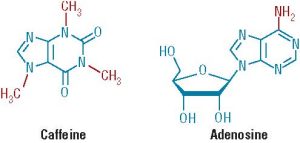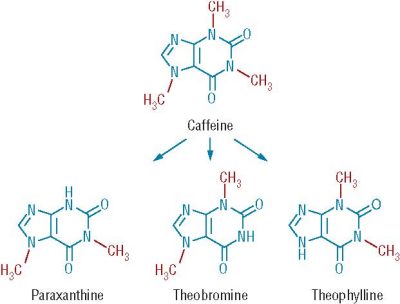Open for Discussion: Caffeine
By Barbara Sitzman and Regis Goode October 2013
Energy Booster

Do you feel like a zombie in your 8 a.m. class? The National Sleep Foundation reports that teenagers need about 9¼ hours of sleep to do their best. The sleep-inducing hormone, melatonin, is produced around 11 p.m. Let’s do the math; 11 p.m. + 9 hours… You are definitely not ready to face the world until 8 a.m. Classes should begin at 9 a.m.! To wake up your brain and concentrate during first-period chemistry, you grab coffee on your way to school. Manufacturers now focus their marketing on new products that are designed for those “not-so-morning” people. How about Wired Waffles washed down with Kickstart Fruit Punch? These products advertise: increased energy, weight loss, enhanced physical and mental performance. What do they have in common? Caffeine!
Caffeine in the Brain

Caffeine is structurally similar to adenosine, found in our brains. Both molecules are water and fat soluble so they easily cross the blood-brain barrier. In the brain, adenosine protects us by slowing nerve cell activity. Due to its similar structure, caffeine binds to the adenosine receptors. Caffeine therefore, not only blocks adenosine’s ability to slow nerve activity, but it increases nerve activity, leaving us stimulated, more alert, energetic, and occasionally with coffee jitters.

Caffeine in the Liver
In the liver, caffeine is broken down into three molecules.

| Molecule | Effects on the Body |
|---|---|
| Paraxanthine | Improves athletic performance by releasing fat to fuel muscles |
| Theobromine | Increases oxygen and nutrients to the brain. |
| Theophylline | Increases heart rate and force of contraction. |
Caffeine occurs naturally in foods such as coffee, tea, and chocolate. It is commonly added to other products to give a morning jolt or an afternoon “pick-me-up” (table below). How
much caffeine per day is safe? For teenagers: 200–300 milligrams (mg); for adults: 400 mg. But metabolic systems differ. Also, some antibiotics block the breakdown of caffeine, and combining caffeine with alcohol can be dangerous. You may feel the effects of caffeine within half an hour, and these effects can last 4–6 hours. Caffeine stimulates the brain like amphetamines, so the following overdose symptoms are similar: nervousness, headache, and rapid heartbeat So how much caffeine do you ingest daily?
Try calculating your daily total
| “Energy” Food | Size | Caffeine (mg) |
|---|---|---|
| Coffee | 5 oz. | 100 |
| Soda | 12 oz. | 50 |
| Wired Waffles | 1 waffle | 200 |
Kickstart Fruit Punch | 16 oz. | 92 |
Cracker Jack’D | 1.25 oz. | 100 |
5-Hour Energy Shot | 1.93 oz. | 215 |
Jolt Energy Gum | 1 stick | 45 |
Extra Strength Excedrin | 2 tablets | 130 |
Also in the October 2013 issue

Some animals keep warm at frigid temperatures, while others stay cold when it is scorching hot. These animals have amazing adaptations that allow them to thrive in the most hostile environments.

